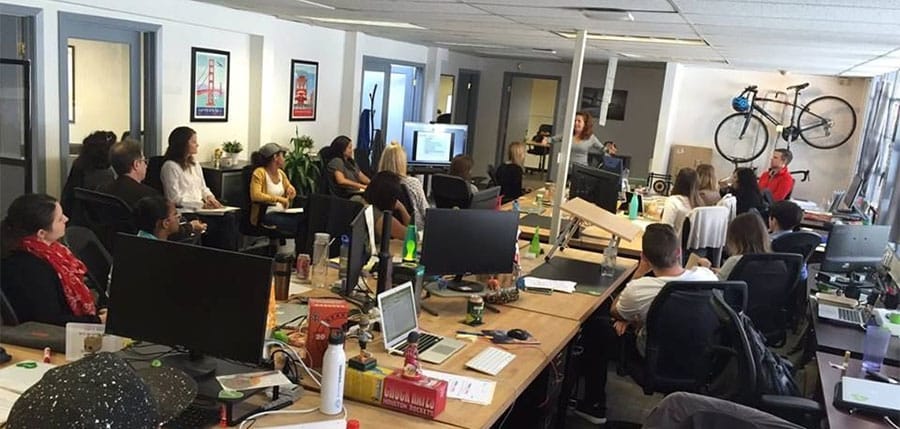The New Technology Workplace: 5 Predictions for the Future of Talent Development in 2017

Rob Cahill, CEO of Jhana, reveals his top predictions for the state of organizational learning and development in 2017 and highlights some of the most critical steps CEOs can take to retain top talent.
News pundits, CEOs, academics and average Joes agree, 2016 has been a crazy ride.
For better or worse, the last 12 months have brought a dizzying array of challenges, changes and—I’ll venture—opportunities, both for companies and their employees… so long as they’re prepared to adapt.
For employees, the opportunities are clear. Talented workers are highly informed, eager to learn and won’t hesitate to take their skills elsewhere if they aren’t receiving the development opportunities they need.
For companies and their CEOs, I’d argue that the opportunity is equally clear, if a bit more complex. To meet the demands of the modern workforce, successful organizations will evolve their approach to both learning and leadership.
Companies who still rely on a one-size-fits-all approach to talent development do so at their peril. Likewise, leaders must recognize that keeping top performers in place will require greater transparency, autonomy and flexibility at work.
With 2017 just around the corner, here are five talent trends I predict will have a significant impact on retention and corporate success.
- Collective leadership will disrupt the traditional hierarchy.
According to the 2016 Global Human Capital survey from Deloitte, “The traditional pyramid-shaped leadership development model is simply not producing leaders fast enough to keep up with the demands of business and the pace of change.” Not only that, but today’s leaders often are in charge of teams that have an incredibly diverse range of skill sets—in other words, managers may be leading people who know more than they themselves do on certain topics. This diversity of experience and perspective offers a unique and valuable opportunity for employees at all levels to help drive innovation and shape strategy. It’s a wonderful platform for company growth… but only if leaders let it happen.2017’s learners will be looking for autonomy. While they still want and need leadership and guidance from an invested management staff, they also want the freedom to take responsibility for their own learning using technology to gather, sift through and apply relevant information in the way that’s easiest and most relevant for them.
To take advantage of this shift, companies must be willing to think beyond “traditional” training methods such as all-day classes for new managers. While instructor-led training has a place, leaders should focus first on guiding employees when and where they need it. While there will always be exceptions, most employees will learn better the field with access to the people and hands-on content that will help them develop in real time.
- The need for bite-sized content will increase.
Numerous studies look at the effects of Google search, social media, and gamification on how today’s adults receive and digest new information. In a corporate world where adult learners increasingly are distracted, overwhelmed and impatient, the takeaway is a simple one. To reach and hook employees with a limited attention span and tight schedule, content must be easily searchable, bite-sized and available anywhere, anytime and from any device.
It’s not enough to put content into a generic shared server. To improve the truly abysmal usage rates of corporate eLearning, companies must make content accessible, digestible and engaging. To keep employees “hooked,” those developing learning content in 2017 must begin thinking in terms of minutes, not hours.
- Learning automation will increase, and so will leadership personalization.
Talent development in 2017 will be a far cry from the days when all new managers were herded into a classroom for a day-long training, or received critical information through a standard handbook, updated quarterly.Now, new technologies are helping executives deliver personalized learning experiences to employees automatically, such as via email or push notifications. That said, there is no single “right” approach to developing employees, no silver bullet combination of people, process and technology that will work for every company or even every employee. While one person may get the most value from attending a class, the next may prefer to learn online in bite-sized snippets. Others may find that different formats work in different circumstances.
Today’s learners want a say in where and how they develop their skills. While talent development teams and resources are still a critical part of your overall talent development strategy, managers are equally, if not more important, to helping employees reach their full potential. Managers know their teams better than anyone. They understand their direct reports’ motivations, career goals and growth opportunities. At least, if they’re good managers, they do! And if your company’s managers aren’t effective, remedying that should be your number one priority in 2017.
No matter how much technology evolves, the human aspect of talent development is not going away. Leadership cannot be automated.
- Connections will morph into communities.
Today’s employees have more resources at their disposal than any of their predecessors and precious little time to make sense of it, meaning that in 2017, the need for wider, more connected communities in which they can share and learn from one another will become increasingly evident.
For better or worse, if employees aren’t getting the information they need from within the company, they are almost certain to go hunting through external sources to find something that matches up. The danger in this bears resemblance to the so-called “fake news” phenomenon. While it’s nice to think that all employees will be diligent in seeking out legitimate sources, all too often, the first link seen is the first link clicked. By creating opportunities for employees to learn from one another and congregate into communities that share knowledge and resources talent development teams can get in front of this problem and help employees conquer information overload at the same time.
- ROI is so 2016. ROD will be 2017’s hot acronym.
It’s always been hard to quantify the ROI of learning investments, and the truth is, it’s probably not possible to tie every single training program directly to financial gains. This has historically led to challenges as talent-focused executives argue for the budget to implement new training tools and programs. Instead of looking for a hard dollar return on investment, smart companies are looking instead at the business impact of their development efforts, aka return on development (ROD).According to Deloitte, 51 percent of companies directly correlated business impact to HR programs in 2016, up from 38 percent in 2015. Continuing this trend, I believe identifying new ways to increase ROD will represent one of the biggest investment areas in 2017. Rather than continuing to argue whether their organization should invest more in development, the discussion in 2017 will evolve to focus on how best to invest in talent development.
The most dangerous mindset organizations can adopt in 2017 is “business as usual” (aka, complacency). Just because employees aren’t loudly complaining, doesn’t mean they’re happy with the development opportunities available to them. Likewise, just because a particular talent development strategy worked in the past, it’s unwise to assume it’s your best option in the future.
For businesses everywhere, acquiring, training and retaining great employees, has moved from an HR priority to a business imperative. To stay competitive, companies must rethink their approach to talent development and define a strategy that focuses on the individual and celebrates innovation, not just from the top down, but also from the bottom up.
For my part, I believe that in the face of all this change, great managers are as important as ever. It might be the only thing about work that I’m betting won’t change in the near future.
Bring the best of the CEOWORLD magazine's global journalism to audiences in the United States and around the world. - Add CEOWORLD magazine to your Google News feed.
Follow CEOWORLD magazine headlines on: Google News, LinkedIn, Twitter, and Facebook.
Copyright 2025 The CEOWORLD magazine. All rights reserved. This material (and any extract from it) must not be copied, redistributed or placed on any website, without CEOWORLD magazine' prior written consent. For media queries, please contact: info@ceoworld.biz









